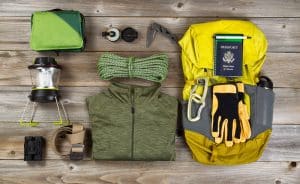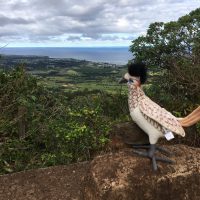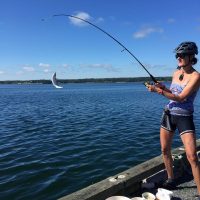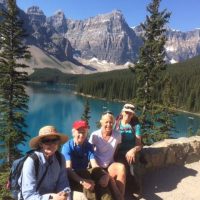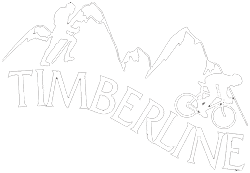Hiking Clothing & Gear
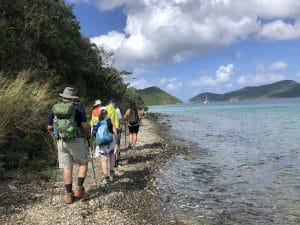
Water carrying capacity is vital, and your daypack may be equipped to carry water containers. Other options are a fanny pack water bottle carrier or a camelback style pack that has both a water bladder (at least 64-ounce capacity) and a separate compartment to carry needed personal articles.
A word about the most important part of your anatomy on a hiking program – your feet! We strongly recommend that you opt to hike in a low-cut, light hiking boot, or hiking specific shoe, rather than sneakers or running shoes, which do not provide sufficient support and traction for trail conditions that we will experience. And, please, do not show up with a brand new pair of shoes that you will be wearing for the first time – be sure in advance that those boots have been “broken-in”, and are a comfortable fit (be aware that a comfortable, snug fit in the store can become agonizingly too tight as your feet swell in the course of an actual hike). Brand new boots can transform a magnificent trek into an excruciating nightmare in an amazingly short period of time. Bring an ample supply of moleskin along to apply to those traditional “hot spots” before they ever become “hot”. A small pair of scissors to cut the moleskin would also be a good idea. We will be equipped to introduce you to the miracle of duct tape.
Hiking Clothing Recommendations
- Hiking specific shoes or boots and socks (multiple sock layers are discouraged)
- Hiking pants, shorts, or zip offs
- Short sleeve T-shirts or synthetic wicking material shirt
- Long sleeve T-shirts (evenings and cool mornings, even for Southwest programs)
- Jacket (fleece, e.g.), sweater or sweatshirt (for warmth)
- Leg tights, warm-up pants
- Rain gear Hat or other head covering (sun hat and warm hat for higher elevation hiking)
- Gloves – lightweight for some cold mornings
- Leisure clothing, including comfortable shoes for evenings (informal, casual and comfortable is the rule – evenings can be cool to cold)
- Swimsuit (always)
- Casual shoes like Tevas, Crocs, or sandals
Personal Articles & Other Gear
- Daypack, comfortable, but big enough for food, water and clothing
- Water containers or bladder, minimum 2 quart capacity, more i
- Sun glasses; Sunscreen and lip protection
- Camera, binoculars
- Moleskin, personal medication and small personal first aid kit
- Hiking (Trekking) poles can be very useful for stability and saving your knees
- National Parks Pass – if you have one, bring it along
Program Recommendations
Tours with overnight wilderness accommodations: (Grand Canyon, Banff)
- You will be carrying all needed equipment on your own. This includes lunch food, snacks and water (extra capacity for Grand Canyon), and clothing for hiking, as usual. In addition, you may want evening or sleeping clothes, a change of footwear, toothbrush etc., overnight medication, a small book or diversion. Pack as light as possible – do not bring clean hiking clothes, yesterday’s will work fine, do not bring unnecessary toiletries or electronics. Your daypack must be large enough to carry all these items. Practice packing your overnight bag at home to be sure it all fits.
Tours involving walking in water (Grand Canyon, Big Bend, Canyonlands, Bryce/Zion, Hawaii)
- Old Sneakers or aqua socks for walking on rocky river bottoms. Tevas are a less desirable option.
Tours in Tropical locations (Hawaii)
- A warmer climate means fleece jackets, leg tights & warm-up pants and gloves are probably not necessary, although at Volcanoes National Park the higher elevation will bring cooler temperatures.
- Rain gear should be lightweight and breathable.
- Trekking poles will be particularly helpful on muddy island hikes, especially Na Pali Coast on Kauai and into the craters of Volcanoes National Park on the Big Island.
- Snorkeling is possible on both Kauai and Hawaii— Mask and snorkel are available to rent, but there are advantages to bringing your own. Fins are readily available for rent and more difficult to pack.

